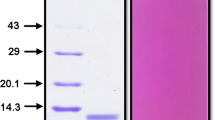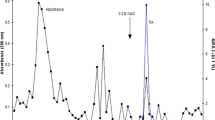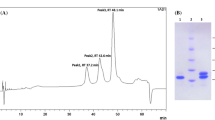Abstract
A purification protocol, involving water extraction, ammonium sulfate precipitation, Sepharose 4B-trypsin affinity and FPLC Superdex G-75 chromatography, was employed to isolate a trypsin inhibitor from Albizzia kalkora seeds. The inhibitor, which had a molecular mass of 19,768.23 Da, consisted of two disulfide-linked polypeptide chains with approximate molecular mass of 15.5 and 4.5 kDa, respectively. It was stable from pH 2–12 for 24 h, whereas it was unstable either above 80°C for 10 min or under reduced condition over 60 min. The inhibitor, which inhibited trypsin activity with an apparent K i of 2.5 × 10−7 M, had one reactive site involved with a lysine residue. Disulfide linkage and lysine residue were important in maintaining its active conformation. Partial amino acid sequence of the purified protein showed a high degree of homology with various members of the Kunitz inhibitor family. Moreover, trypsin-like proteases from larval Helicoverpa armigera, Spodoptera exigua, and Pieris rapae were inhibited for 85, 57, and 68% respectively, by the inhibitor at 45 μg ml−1.




Similar content being viewed by others
References
Beekwilder J, Schipper B, Bakker P et al (2000) Characterization of potato proteinase inhibitor II reactive site mutants. Eur J Biochem 267:1975–1984
Bhattacharyya A, Mazumdar LS, Babu CR (2007) Bioinsecticidal activity of Archidendron ellipticum trypsin inhibitor on growth and serine digestive enzymes during larval development of Spodoptera litura. Comp Biochem Physiol C 145:669–677
Erlanger BE, Kokowsky N, Cohen W (1961) The preparation and properties of two new chromogenic substrates of trypsin. Arch Biochem Biophys 95:271–278
Giri AP, Harsulkar AM, Ku MSB et al (2003) Identification of potent inhibitors of Helicoverpa armigera gut proteinases from winged bean seeds. Phytochemistry 63:523–532
Hanspal JS, Bushell GR, Ghosh P (1983) Detection of protease inhibitors using substrate-containing sodium dodecyl sulfate-polyacrylamide gel electrophoresis. Anal Biochem 132:288–293
Harsulkar AM, Giri AP, Patankar AG et al (1999) Successive use of non-host plant proteinase inhibitors required for effective inhibition of gut proteinases and larval growth of Helicoverpa armigera. Plant Physiol 121:497–506
Inanaga H, Kobayasi D, Kouzuma Y et al (2001) Protein engineering of novel proteinase inhibitors and their effects on the growth of Spodoptera exigua larvae. Biosci Biotechnol Biochem 65:2259–2264
Jongsma MA, Peter J (1995) Adaptation of Spodoptera exigua larva to plant proteinase inhibitors by induction of proteinase activity insensitive of inhibition. Proc Natl Acad Sci USA 92:8041–8045
Knights RJ, Light A (1976) Disulfide bond-modified trypsinogen. J Biol Chem 251:222–228
Laskowski M Jr, Qasim MA (2000) What can the structures of enzyme–inhibitor complexes tell us about the structures of enzyme substrate complexes? Biochim Biophys Acta 1477:324–337
Liao H, Ren W, Kang Z et al (2007) A trypsin inhibitor from Cassia obtusifolia seeds: isolation, characterization and activity on Pieris rapae. Biotechnol Lett 4:653–658
Park SY, Lee WYM, Park YK et al (2006) Effects of nitrogen source and bacterial elicitor on isoflavone accumulation in root cultures of Albizzia kalkora (Roxb.) Prain. J Integr Plant Biol 48:1108–1114
Ryan CA (1991) Proteinase inhibitors in plants: genes for improving defenses against insects and pathogens. Annu Rev Phytolpathol 28:425–449
Terada S, Fujimura S, Katayama H et al (1994) Purification and characterization of two Kunitz family subtilisin inhibitors from seeds of Canavalia lineata. J Biochem 115:392–396
Acknowledgements
This work was supported by grants from the Major Science and Technology Research Program of Ministry of Education of China (No. 104151) and from the Science and Technology Program of Southwest Jiaotong University (No. 20060116).
Author information
Authors and Affiliations
Corresponding author
Rights and permissions
About this article
Cite this article
Zhou, JY., Liao, H., Zhang, NH. et al. Identification of a Kunitz inhibitor from Albizzia kalkora and its inhibitory effect against pest midgut proteases. Biotechnol Lett 30, 1495–1499 (2008). https://doi.org/10.1007/s10529-008-9699-0
Received:
Revised:
Accepted:
Published:
Issue Date:
DOI: https://doi.org/10.1007/s10529-008-9699-0




